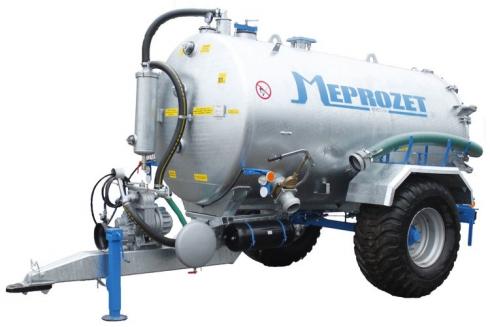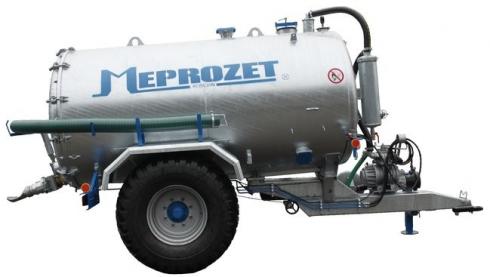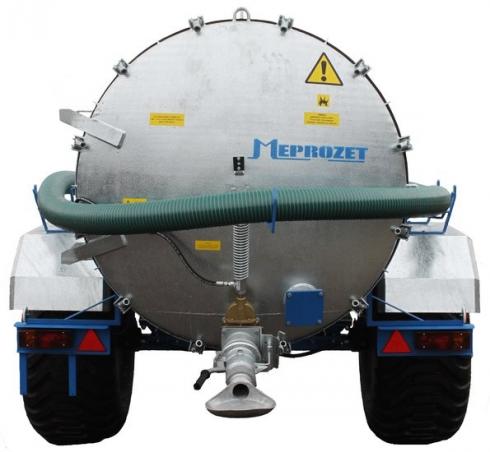Slurry tanker with self-supporting construction PN-60/3
-
Sanitary Sewage Trucks
- Self-supporting constructions
CHASSIS
Slurry tanker PN-60/3 is designed as self-supporting tank, mounted on a single-axle chassis.
TANK
A steel, hot galvanised tank with central frame has internal strengthening rings and baffle. Opened rear head with two connection pipes. 3” sight-glasses are mounted on the front head and connection pipes for valves on sides of the tank. A Ø 200 mm hatch and overflow safety device are placed in the upper part of the tank.
COMPRESSOR
As a standard JUROP PN 58M compressor is mounted on the drawbar.
GATE VALVES
A hydraulically controlled gate valve with a lifted spreading spoon is mounted on the rear head and manual gate valve on the side. A 2" connection pipe is mounted on the bottom of the tank, allowing to connect an additional discharge hose, e.g., for crops watering.
STIRRER
On request, the slurry tanker can be equipped with a hydraulically driven worm stirrer which can stir tank contents continuously.
OPERATION
Tank filling is achieved by vacuum, made in the tank by the compressor, driven by a PTO shaft from the tractor. Tank emptying is done by overpressure or gravitationally enforced.
SPREADING SYSTEMS
Sprinkling is done by a spreading spoon, which is a part of the standard tanker equipment. On request, other spreading devices can be used.
ROAD TRANSPORT
The tanker has got a CE declaration of conformity. The approval certificate allows vehicle registration and opens free access to public roads.
APPLICATION
- pumping out of liquid waste, manure, municipal wastes
- transport and spreading onto fields and grasslands
- crops watering, sprinkling and fertilising
- end-stage fire extinguishing in the woods and in the fields
- water transport to building sites and roads
TECHNICAL DATA
- length - 5 600 mm
- width - 2 550 mm
- height - 2 870 mm
- unladen weight - 2 030 kg
- gross weight - 8 030 kg
- tank capacity - 6 000 l
- number of wheels - 2
- wheel track - 2 000 mm
- tyres - 550 / 60 x 22.5
- vertical load - 11.5 KN
- tractor horsepower - 60 HP
- filling time - 3 min
- spreading spoon spilling width - 14 m
- compressor type - JUROP PN 58M
- compressor capacity - 6 500 l / min
|
Capacity |
PN-60/3 |
Number of axles |
Wheel track |
Wheel setback |
Tyres |
Compressor |
|
6 000 лliters |
version А standard |
1 |
2000 |
220 / 275 / 8 |
550 / 60 x 22,5 |
JUROP |
|
versionB |
1 |
2000 |
220 / 275 / 8 |
20,5 R22,5 |
JUROP |
|
|
version C |
1 |
2000 |
220 / 275 / 8 |
400 R22,5 |
JUROP |
|
|
version D |
1 |
2000 |
220 / 275 / 8 |
600 / 65 - 23 |
JUROP |
|
|
version E |
1 |
2000 |
220 / 275 / 8 |
560 / 60 x 22,5 |
JUROP |
STANDARD EQUIPMENT
- 5" suction hose 6 m long, with a suction strainer
- compressor with a safety valve
- lifted spreading spoon
- damper - oil recuperator
- mudguards
- float valve in the upper part of the tank
- overflow tank
- sight-glasses in the front head
- manometer
- adjustable supporting foot
- replaceable tow eye
- single-line braking system
- 12 V electrical system
- hydraulic system for opening the discharge valve
SPECIAL EQUIPMENT
A slurry tanker, beside its standard version, can also be manufactured in a special version and can have additional components, extending its functionality:
- tyres 20.5 R22.5; 400 R22.5; 560/60x22.5 or 600/65x23
- closed rear head with Ø600 mm hatch
- tank with special paint coating
- brass gate valves on the side of the tank
- Ø 420 mm upper hatch, manual or hydraulic
- ladder
- glass-tube level indicator
- discharge pipe with a 2" valve
- compressor JUROP PN84M or other
- PTO shaft
- double-line braking system
- swivel tow eye or other
- sprinkling distributors for backward or sideward







 Services:
Services: